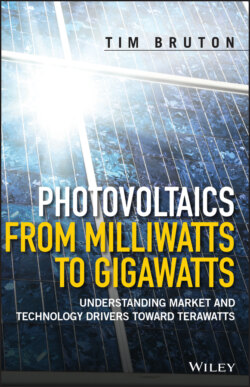Читать книгу Photovoltaics from Milliwatts to Gigawatts - Tim Bruton - Страница 12
1 The Photovoltaics: The Birth of a Technology and Its First Application 1.1 Introduction
Оглавление‘For more than a generation, solar power was an environmentalist fantasy, an expensive and impractical artefact from the Jimmy Carter era. That was true right up to the moment it wasn’t’ [1]. This quotation neatly encapsulates the theme of this book: how a technology grew from a high‐cost product in a specialist application to a global technology supplying a significant proportion of the world’s electricity against a background of at best scepticism and at worst open hostility. In 2018, 102 GWp of photovoltaic modules were installed globally, leading to a total installed capacity of 509 GWp, while an independent study showed that photovoltaics was the lowest‐cost means of generation of new‐build electricity‐generating capacity, including nuclear and fossil fuel sources [2]. At the end of 2019, photovoltaics provided 3% of the global electricity supply, but the expectation is that this percentage will continue to rise until it is the dominant electricity‐generating technology by 2050, with 60% of global output [3,4]. Figure 1.1 shows the expected growth of all generating technologies to 2050.
This dramatic development of photovoltaic installations has been the work of many inspired individuals. Their stories are told in other places [5–7]. The aim of this book is to describe how the technology changed from small‐area solar cells of 10% efficiency conversion of sunlight to electricity to the mass‐production cells of today, with efficiencies in the range 20–24%, and the route to >30% becoming clear. The present chapter describes how the potential for photovoltaic conversion was first recognised and how it moved into the early stages of commercialisation as a high‐technology product for use in powering space satellites. Later chapters will describe how this space technology became a terrestrial one and the driving forces and technology developments that made it the global force it is today. Furthermore, the options for going beyond the current technology will be reviewed and the route to achieving terawatt global installations discussed.
It should be no surprise that photovoltaics has achieved the advances it has. Since the invention of the semiconductor transistor in 1948, solid‐state electronics has transformed the way in which we live. Computers, mobile phones, the Internet, and so much else would not exist without the underlying semiconductor technology. Photovoltaic solar energy conversion is the application of solid‐state technology to the energy field. Electricity is generated simply by the absorption of sunlight in a semiconducting diode. There are no moving parts. No liquid or gaseous fuels are needed. There are no effluents requiring disposal and no noise is generated. Sunlight is abundant, delivering to the earth’s surface 6000 times humanity’s total energy usage [8]. It is the only renewable resource capable of delivering the world’s energy needs carbon‐free by 2050, and it will remain available for the next 5 billion years. The photovoltaic technology is easily scalable, so that small cells can generate the few milliwatts required for consumer devices such as calculators and watches, while larger ones can be used to assemble modules for deployment at the gigawatt level. It is these advantages which spurred many advocates to continue to promote photovoltaics in the face of significant opposition.
Figure 1.1 Evolution of electricity‐generating technologies to 2050
Source: DNV GL Energy Transition Outlook 2018
